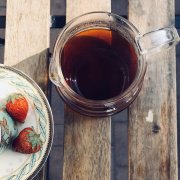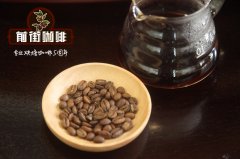Introduction to Colombian Coffee at Hacienda Mallorca Manor in Mayuca, Colombia

Professional coffee knowledge exchange more coffee bean information please follow the coffee workshop (Wechat official account cafe_style)
The Hacienda Mallorca estate, which is run by Santiago Londo ñ o, is owned by his father and his uncle and has been growing coffee since 1932. The estate is in the Valle del Cauca valley, near the neighboring border producing town of Caicedonia, where his family has produced a lot of raw coffee beans and owns several estates for many years. After completing his MBA studies, Santiago Londo ñ o decided to return to work at the Hacienda Mallorca estate and start a sustainable project. During this time, he replanted shade trees.
Hacienda Mallorca Manor mainly grows Kaddura (Caturra). Four years ago, his family decided to plant Geisha and Yellow Bourbon, which are rarely grown in Colombia. These two varieties of coffee are shaded by banana trees. Banana trees are also used to observe the effects of sun shade on coffee growth and harvest. Banana trees not only provide soil moisture, but also slow down the ripening rate of coffee fruits. Make the coffee flavor more ideal and excellent. In the operation and management of the manor, Santiago must adopt new raw bean treatment methods, such as sun and honey treatment. On the one hand, it can use different treatments to test special flavors, and it can also diversify its products to meet the needs of the market. Santiago manages the manor, focusing on the details of each production batch to improve the quality of coffee production and traceable surnames. Set up a constant temperature warehouse and place each batch of raw beans at 19 degrees C. Each batch of raw beans cooked in the warehouse will be sent to the nearby quality cup testing company Caf é Y Procesos to assist in cup testing and grading, which helps to grade and mix three kinds of mixed beans and sell them in the market.
The main coffee producing areas in Colombia are: Huila (San Augustin), Narino, Tolima, Popayan (Cauca), Valle de Cauca, Meta, Antioquia (Medellin),
Magdelena (Sierra Nevada), Boyaca, Santander (Bucaramanga), etc. There are 700 million coffee trees documented in Colombia, 66% of which are planted in plantations in modern ways, and the rest in small, traditionally run farms. The main varieties include Kaddura Caturra, Colombia Colombia, Tibica Tipica, Bourbon Bourbon, Elephant Bean Maragogype, and Tabi. Farms and cooperatives throughout the country, big or small, are distributed in more than 500000 municipalities and 14 major coffee-producing areas. A total of 2 million Colombians depend on coffee cultivation for a living, contributing 12.5 per cent to gross domestic product. In the early 1960s, coffee production was about 600 kg per hectare, but now it has increased to about 900 kg. The farm can reach 2500 kilograms. Colombia established the National Coffee Management Association in 1927, which is responsible for quality supervision. Although the association is a private organization, it acts on behalf of the government. In addition to organizing the industry, the association is also responsible for the control of coffee prices and responsible for health care, education, road construction, hiring planting technicians, conducting investigations, supervising product quality, and directly managing the export business of 50% of the total export volume. Hire marketing staff and other duties. Like the National Coffee Management Association in Kenya, it is a model for the management of coffee organizations.
Qianjie recommended cooking parameters:
Hand punch: V60 filter cup small Fuji R440 grinding 3.5, water temperature about 90 degrees
The recommended grinding degree of normal pressure is 4 and the water temperature is 90 ℃.
The recommended siphon grinding degree is 4, and the water temperature is 90 ℃ ~ 91 ℃.
The pressure grinding degree of Philharmonic is recommended to be 3.5, and the water temperature is 90 ℃.
Important Notice :
前街咖啡 FrontStreet Coffee has moved to new addredd:
FrontStreet Coffee Address: 315,Donghua East Road,GuangZhou
Tel:020 38364473
- Prev

Montecillos Montecillos and Comayagua
Professional coffee knowledge exchange More coffee bean information Please pay attention to Coffee Workshop (Weixin Official Accounts cafe_style) Fascinating Honduras Coffee Regions: Montecillos and Comayagua Honduras Coffee Production Area MONTECILLOS 1200-1700 Altitude Cup Test Features: Coffee in this area has sweet aroma of fruit, lively and bright acidity
- Next

Honduras Benigno Mejia small Farmer hundred Flowers Manor Information 2017COE Champion Coffee
Professional coffee knowledge exchange more coffee bean information please follow the coffee workshop (Wechat official account cafe_style) Honduras Benigno Mejia small Farmer Parainema species Honduras hundred Flower Manor Benigno Mejia small Farmer legendary Parainema species Honduras has been growing coffee for more than 200 years (since 1804) statistics now cover an area of 20
Related
- Does Rose Summer choose Blue, Green or Red? Detailed explanation of Rose Summer Coffee plots and Classification in Panamanian Jade Manor
- What is the difference between the origin, producing area, processing plant, cooperative and manor of coffee beans?
- How fine does the espresso powder fit? how to grind the espresso?
- Sca coffee roasting degree color card coffee roasting degree 8 roasting color values what do you mean?
- The practice of lattes: how to make lattes at home
- Introduction to Indonesian Fine Coffee beans-- Java Coffee producing area of Indonesian Arabica Coffee
- How much will the flavor of light and medium roasted rose summer be expressed? What baking level is rose summer suitable for?
- Introduction to the characteristics of washing, sun-drying or wet-planing coffee commonly used in Mantenin, Indonesia
- Price characteristics of Arabica Coffee Bean Starbucks introduction to Manning Coffee Bean Taste producing area Variety Manor
- What is the authentic Yega flavor? What are the flavor characteristics of the really excellent Yejasuffi coffee beans?

